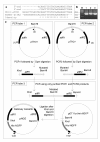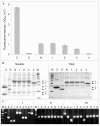One-step generation of error-prone PCR libraries using Gateway® technology
- PMID: 22289297
- PMCID: PMC3349575
- DOI: 10.1186/1475-2859-11-14
One-step generation of error-prone PCR libraries using Gateway® technology
Abstract
Background: Error-prone PCR (epPCR) libraries are one of the tools used in directed evolution. The Gateway® technology allows constructing epPCR libraries virtually devoid of any background (i.e., of insert-free plasmid), but requires two steps: the BP and the LR reactions and the associated E. coli cell transformations and plasmid purifications.
Results: We describe a method for making epPCR libraries in Gateway® plasmids using an LR reaction without intermediate BP reaction. We also describe a BP-free and LR-free sub-cloning method for in-frame transferring the coding sequence of selected clones from the plasmid used to screen the library to another one devoid of tag used for screening (such as the green fluorescent protein). We report preliminary results of a directed evolution program using this method.
Conclusions: The one-step method enables producing epPCR libraries of as high complexity and quality as does the regular, two-step, protocol for half the amount of work. In addition, it contributes to preserve the original complexity of the epPCR product.
Figures




References
Publication types
MeSH terms
LinkOut - more resources
Full Text Sources
Other Literature Sources

